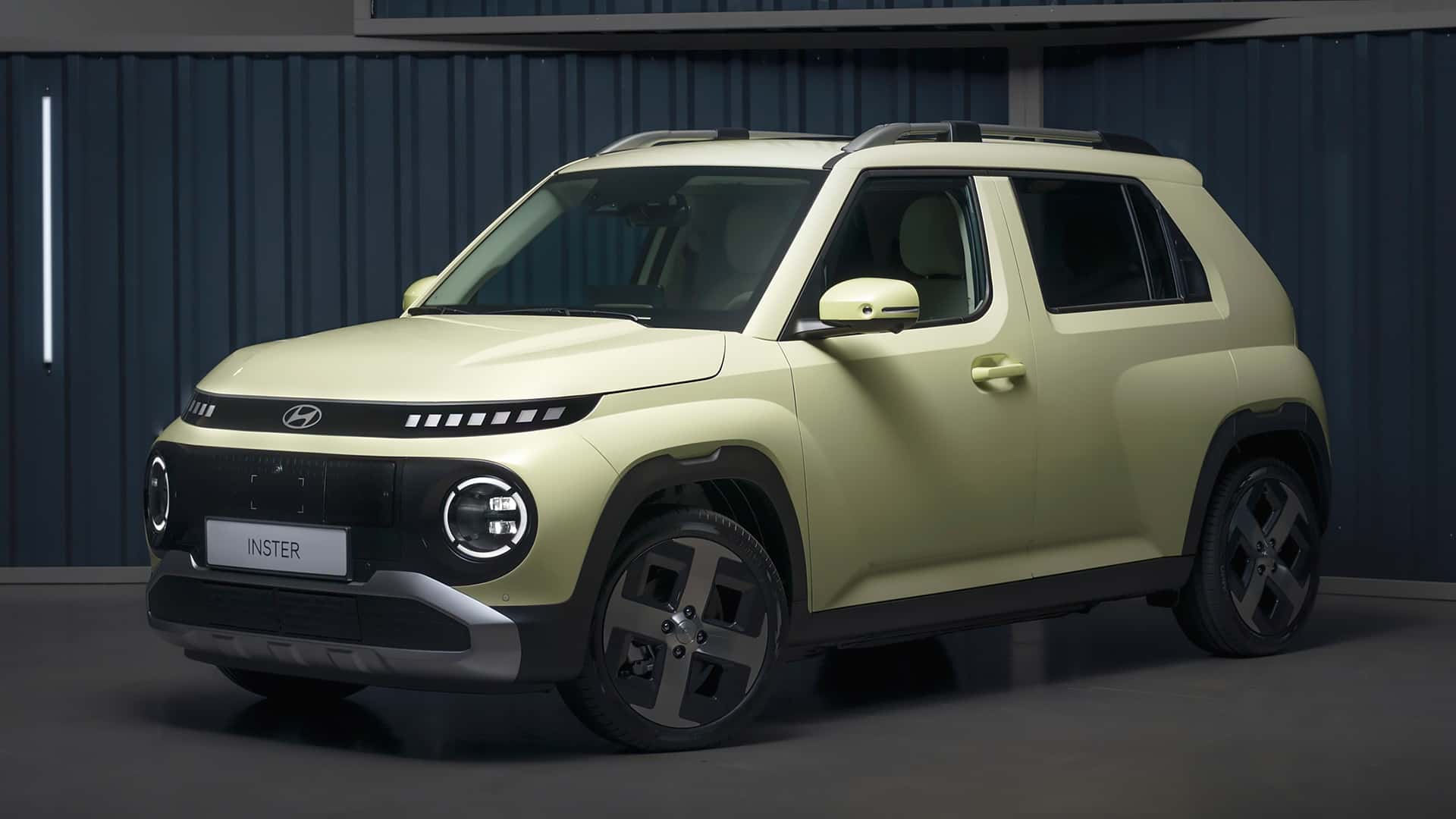
HYUNDAI INSTER: ENTRY-LEVEL EV GOES AFTER DACIA SPRING IN EUROPE
Based on the South Korean-spec Casper, Hyundai’s new city EV goes to Europe with an extended wheelbase and two battery options.
This is the all-new Hyundai Inster. An entry-level, A-segment electric city car designed specifically for Europe that will likely compete with the Chinese-made Dacia Spring, which is one of the cheapest cars on sale in the European Union.
Keen-eyed observers might have noticed that the new Inster looks pretty much identical to the Korean-market Casper, and you’d be right. But looks aren’t everything, as Hyundai seems to have done its homework and didn’t just slap some lipstick and bolt a big battery under what was originally a combustion-powered urban runabout.
The biggest change for the European-bound Inster EV is a stretched, 101.5-inch (2,580-millimeter) wheelbase, bringing it closer to a subcompact or B-segment car. That’s 7 inches more than the gas-powered Casper it’s based on, 6 inches more than the Dacia Spring and 10 inches more than the rather pricy Fiat 500e.
More Affordable EV Stories
- A Kia EV3 Built In Mexico Could Be A Sub-$30,000 Electric Car
- Jeep's $25,000 EV Will Be The Next Renegade
- Ford's Affordable EV Is From A Crack Team Of Tesla, Apple And Rivian Vets
- Long-Range EVs Are Finally Cheaper Than Average Gas Cars
Measuring 150.6 inches long, 63.3 inches wide and 62 inches tall, the new Inster EV is about 6 inches longer, 2.7 inches narrower and its wheelbase is 6.1 inches longer than the entry-level combustion Hyundai i10. All of this should translate into more than a decent interior room for the size of the car, but bear in mind that it’s still pretty small by American standards–the discontinued Chevrolet Bolt subcompact EV is almost 10 inches longer while the wheelbase is 1 inch longer.
Battery and range
Two battery powertrain options will be available. The entry-level Inster will come with a 42-kilowatt-hour battery and a 71.1-kilowatt (95-horsepower) electric motor, while the fancier version will get a 49-kWh battery pack and an 84.5-kW (113 hp) motor. The torque figure is 108 pound-feet (147 Newton-meters) for both.
For the base battery pack, Hyundai expects a WLTP range of 186 miles (300 km). With this version, the zero to 62 miles per hour sprint can be achieved in 11.7 seconds, while the top speed is 87 miles per hour (140 kilometers per hour).
Hyundai Inster (2024)
In the case of the Inster with the larger battery, Hyundai targets a WLTP-rated range of 220 miles (355 km), which is 80 miles more than the Dacia Spring is capable of. The power output of the Inster is also almost double compared to the Spring’s maximum 48 kW (64 hp), allowing it to sprint to 62 in 10.6 seconds and reach a top speed of 93 mph (150 kph). The Inster also boasts a battery heating system and a heat pump.
In typical Hyundai fashion, the maximum DC fast charging rate is nowhere to be found in the official press release, but the automaker said that both battery versions can be topped up from 10% to 80% state of charge in 30 minutes, which is rather impressive. The company claims the energy consumption is 15.3 kWh/100 km or 4.06 miles/kWh.
The standard onboard AC charger is rated at 11 kW and there’s vehicle-to-load capability built-in, but the company didn’t say what’s the maximum power output.
Hyundai Inster (2024) V2L
As a reminder, the new Inster is not based on the EV-specific E-GMP platform that’s used for larger models like the Hyundai Ioniq 5 and Kia EV9. Instead, it uses an ICE platform that has been adapted for an electric powertrain.
Plenty of standard features
On the outside, the new affordable EV comes with digital-pixel LED daytime running lights and rear LED lights as standard. Three wheel options are available, starting with 15-inch steelies with wheel covers as part of the base package, while 15- and 17-inch alloys can be specced for extra cash.
Inside, the Hyundai Inster EV has seating for four, but a five-seater version is coming next year. At the front, the floor is flat and there’s no center console between the seats, allowing the driver to easily scooch to the right and get out of the car through the front passenger’s door if there’s not enough space on the driver’s side.
The rear seats can slide front and rear to increase or decrease the legroom and cargo space. With the seats moved all the way back, the trunk has a volume of 8.4 cubic feet (238 liters). Sliding them all the way forward increases that figure to 12.4 cu ft (351 l) while folding them flat will result in a cargo volume of 37.4 cu ft (1,059 liters).
A pair of 10.25-inch screens–one for the digital instrument cluster and one for the infotainment system–come as standard, as well as a one-touch sunroof, a heated steering wheel, a wireless charging pad for smartphones and a pretty long list of advanced driving assistance systems (ADAS), including smart cruise control with stop and go, forward collision-avoidance assistance, surround-view monitor, lane-keeping assist and lane-following assist. Wired Apple CarPlay and Android Auto are also available.
Hyundai Inster EV price
The Korean automaker hasn’t released the pricing for the all-new Inster EV. However, we know from previous reports that quoted Hyundai France boss Lionel Keogh, who said that the entry-level battery-powered hatchback would be priced around €20,000, which is roughly $21,500 at current exchange rates, including value-added tax (VAT).
2024-06-27T01:06:35Z dg43tfdfdgfd